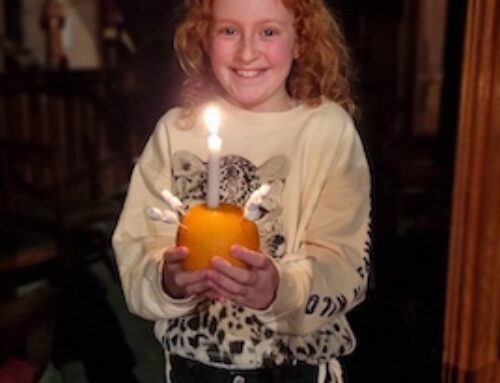At our main services this morning Fr Mark celebrated, while Ordinand Danny gave a commentary on why we were doing what we do in the service:
- Introductory Rites – The introductory rites are the beginning part of the service where we, the gathered people of God, step out of the busy world with its hustle and bustle, its pulls and its draws, and its temptations that lead us away from Christ. It is here where we step into a holy and sacred space, detaching ourselves temporarily from the world in which we live, and through the liturgy and the power of the Holy Spirit, into a thin space where we can encounter the presence of God more deeply and more intimately than perhaps we do through the week. It is also in this eucharistic space where we discover more of who we are, as our souls require, and as the Spirit leads us.
- As the gathered people sing Gods praises in the opening hymn, we prepare our hearts and minds to meet with the Living God. The serving party process in with the Gospel, accompanied by the acolytes carrying candles and a processional cross, which have theological significance; the Word of God, light of the world, Jesus Christ being present among His people and leading them out of darkness, with the cross reminding the gathered people of the instrument of our salvation.
- The priest will prepare the altar for the act of worship in the Eucharist, censing the altar to both purify and sanctify it for this purpose. As well as this, the smoke and smell have theological significance; it engages the sense of smell, and in doing so draws more of our whole self to worship God, and also invokes Psalm 141:2 – Let my prayer be counted as incense before you, and the lifting up of my hands as an evening sacrifice.
- The trinitarian formulaic opening reminds us of Gods relational nearness and approachability, and the sign of the cross is not just a ritual exercise, but an outward and distinguishing sign of who we belong to, and so receive His blessing, and begin the service in love, by using the symbol of the greatest act of love ever shown
- Penitential Rites – This part of the service is one of the most crucial, as it is here where we humbly acknowledge and confess our sin before God, not to be humiliated, but to receive the forgiveness only He can give. Speaking in the power and the name of Christ, the priest gives the Absolution, and therefore cleanses the body of Christ gathered in this place, liberating us from our sin, and so prepares us even further to receive the Sacrament of the Eucharist. As the forgiven people of God, we then say or sing the Gloria, a song of Gods Glory, and celebratory anthem that speaks of the mystery of our salvation in Christ.
- The Collect – This prayer for the day is prayed across the whole Anglican body across the world, to strengthen and unite us as one Church in our petitions before God.
- The Word of God – Now we hear the Word of God spoken to us. The words of the Bible is where we hear the Word of God speaking to us today, and this requires us to be still and to approach it with open hearts, open ears and open minds, allowing God to minister to us as He chooses and sees fit. Scripture is our daily bread, and it is vital to our discipleship as we seek to formed by the Spirit to be more like Christ. The whole canon of the Bible was given to the whole people of God, and this is why we hear a reading from the Old Testament, a Psalm, a New Testament reading and a reading from one of the four Holy Gospels, as simply hearing our favourite passages over and over again doesn’t honour the authority given to the whole of Scripture. The Gospel is processed once more, as it contain the words and teachings of the Living Word of God, the King of Kings, our Lord Jesus Christ, and so is given a level reverence.

- The Sermon – The preacher will now open up the Word of God, and speak in the name of the Father, Son and Holy Spirit, to speak what the Lord has laid on their heart, and in turn, help us to understand more deeply what the Scriptures say to us today, and to help us connect with the Scriptures more deeply than on first hearing.
- The Creed – The Creed is where we affirm as the Church of God what we believe in, and so profess our faith as part of that One Body, with believers around the world, expressing the mystery of our lives redeemed by Christ on the Cross. The Creed shapes, purposes and directs a living faith in Christ, summarizing the central teachings of Scripture, whilst also providing a succinct summary of the essentials of the faith.
- Prayers of Intercession – In this part of the service, we bring the concerns of the wider Church, our wider world and our community into the context of worship through the prayers of intercession. These prayers are prayed in faith by the Church in the name of Jesus, recognizing that He is sovereign over all things, able to do all things, and so inviting Him to work in and through the Spirit to answer these petitions.
- The Peace – The Peace is the outward action that points toward Godly union with God and one another, and is made before the preparation of the Gifts, to signify that what we are about to participate in is a family meal, and so be at peace with one another before receiving. This invokes Matthew 5:23-24 – if you remember that your brother or sister has something against you… first be reconciled to your brother or sister, and then come and offer your gift.
- The Eucharist Celebration – As with any formal meal, the table must first be prepared. The Altar is censed once more, as is the priest and the Gifts of bread and wine, to sanctify and purify them in preparation for their role in the Eucharist. The Altar is prepared for the Eucharistic celebration, and water and wine are mixed in the chalice during the preparation, with this known as commingling. It points toward the humble nature of Christ divine choosing to take human form, and so in the Eucharist itself, the celebrant becomes one with God in consuming the ‘body and blood’ of Christ. The gathered people of God then acknowledge the presence of God, by lifting our hearts, praise and thanksgiving to Him, before the act of consecration that will follow.

- The priest then proceeds to lead the gathered congregation in the Eucharistic Prayer, through prayers of praise and thanksgiving, as well as recalling the Last Supper in the liturgy, re-inviting the gathered body of Christ to remember our shared story, the story that reveals who and whose we are, and to whom we are here to remember and worship. The ringing of the bells is done to draw attention to the transformative presence of God in the Eucharist, and that something holy is happening.
- The calling down of the Holy Spirit, known as the prayer of the epiclesis, to consecrate the elements of bread and wine is where the meal becomes more than just the earthly vessels of bread and wine, and becomes the holiest of all meals. What exactly happens here is where theologies sometimes differ, but the presence of Christ himself within the bread and the wine is the central most important thing to keep in mind here. Whatever happens spiritually in this moment is something that is beyond earthly words and human explanation, but it is where Christ veils himself so that we can approach him without fear, but in intimacy.
- The celebrant will then elevate the bread and the wine, enabling the gathered worshippers to gaze on Christ, and meditate on his giving of self in this meal to sustain those who are to feed on him in body, mind and spirit. Then comes the breaking of the now consecrated bread, symbolising Jesus’ willingness to be broken for the world by going to cross and dying, to pay the wages of sin forevermore. This, along with the Agnus Dei, reminds those gathered of their own brokenness as human beings, and as such, the need of Jesus’ presence in their lives.
- Finally, the gathered Church will say together the Lord’s Prayer, a prayer of unity in faith, before re-affirming that they are one body, gathered around the One God, made present in the consecrated bread and wine, and that through this meal, they will receive the presence of Christ. The celebrant will then extend the invitation to all those gathered who profess Jesus as Lord, to come and eat at the table of Christ, to be nourished both physically and spiritually by him at the table ahead of the continuing journey with God that will continue after the service.

- The final is the thanksgiving for the meal, and the dismissal, and this is where the body of Christ will be broken again, this time in the form of the gathered disciples dispersing, to be Christ’s hands and feet in the world, and so giving of ourselves, just as Christ gave himself to the world. This giving of self is only possible through the provision and sustenance of the Holy Spirit, and through the nourishment received in the Eucharist, nourishment that will inevitably be used and exhausted in that process of giving of self. Therefore, in order to serve Christ more fully, His followers should return time and time again to his table in the Eucharist to be nourished and re-nourished, in order to grow, and so serve Christ more fully and so more effectively in the world.
We are grateful to Anselm Grun “The Seven Sacraments” Continuum 2003 for much of the information in this presentation.




